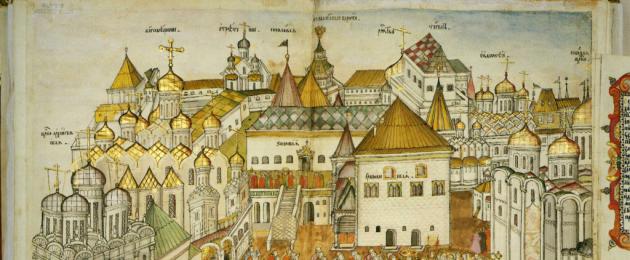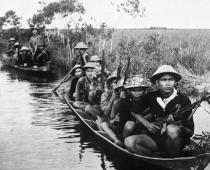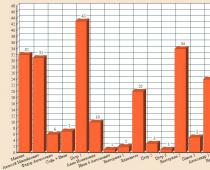Line UMK I. L. Andreev, O. V. Volobuev. History (6-10)
Russian history
How did Mikhail Romanov end up on the Russian throne?
On July 21, 1613, the wedding of Mikhail to the kingdom took place in the Assumption Cathedral of the Moscow Kremlin, which marked the founding of a new ruling dynasty of the Romanovs. How did it happen that Michael ended up on the throne, and what events preceded this? Read in our material.On July 21, 1613, the wedding of Mikhail to the kingdom took place in the Assumption Cathedral of the Moscow Kremlin, which marked the founding of a new ruling dynasty of the Romanovs. The rite, which took place in the Assumption Cathedral in the Kremlin, was carried out not at all according to order. The reasons for this lay in the Time of Troubles, which disrupted all plans: Patriarch Filaret (by coincidence, the father of the future king), was captured by the Poles, the second head of the Church after him, Metropolitan Isidore, was in the territory occupied by the Swedes. As a result, the wedding was performed by Metropolitan Ephraim, the third hierarch of the Russian Church, while the rest of the heads gave their blessing.
So, how did it happen that Mikhail ended up on the Russian throne?
Events in the Tushino camp
In the autumn of 1609, a political crisis was observed in Tushino. The Polish king Sigismund III, who invaded Russia in September 1609, managed to split the Poles and Russians, who had united under the banner of False Dmitry II. The intensified disagreements, as well as the dismissive attitude of the gentry towards the impostor, forced False Dmitry II to flee from Tushin to Kaluga.On March 12, 1610, Russian troops solemnly entered Moscow under the leadership of the talented and young commander M.V. Skopin-Shuisky, the tsar's nephew. There was a chance of a complete defeat of the forces of the impostor, and then the liberation of the country from the troops of Sigismund III. However, on the eve of the march of the Russian troops (April 1610), Skopin-Shuisky was poisoned at a feast and died two weeks later.
Alas, already on June 24, 1610, the Russians were utterly defeated by Polish troops. At the beginning of July 1610, the troops of Zholkevsky approached Moscow from the west, and the troops of False Dmitry II again approached from the south. In this situation, on July 17, 1610, through the efforts of Zakhary Lyapunov (brother of the rebellious Ryazan nobleman P.P. Lyapunov) and his supporters, Shuisky was overthrown and on July 19 he was forcibly tonsured a monk (in order to prevent him from becoming king again in the future). Patriarch Hermogenes did not recognize this tonsure.
Seven Boyars
So, in July 1610, power in Moscow passed to the Boyar Duma, headed by the boyar Mstislavsky. The new provisional government was called the "Seven Boyars". It included representatives of the most noble families F. I. Mstislavsky, I. M. Vorotynsky, A. V. Trubetskoy, A. V. Golitsyn, I. N. Romanov, F. I. Sheremetev, B. M. Lykov.The balance of power in the capital in July - August 1610 was as follows. Patriarch Hermogenes and his supporters opposed both the impostor and any foreigner on the Russian throne. Possible candidates were Prince V.V. Golitsyn or 14-year-old Mikhail Romanov, the son of Metropolitan Philaret (former Patriarch of Tushino). So for the first time the name of M.F. Romanova. Most of the boyars, led by Mstislavsky, the nobles and merchants were in favor of inviting Prince Vladislav. Firstly, they did not want to have any of the boyars as tsar, remembering the unsuccessful experience of the reign of Godunov and Shuisky, secondly, they hoped to receive additional benefits and benefits from Vladislav, and thirdly, they feared ruin during the accession of an impostor. The city lower classes sought to put False Dmitry II on the throne.
On August 17, 1610, the Moscow government concluded an agreement with Hetman Zholkiewski on the terms of inviting the Polish prince Vladislav to the Russian throne. Sigismund III, under the pretext of unrest in Russia, did not let his son go to Moscow. In the capital, hetman A. Gonsevsky ordered on his behalf. The Polish king, possessing significant military strength, did not want to fulfill the conditions of the Russian side and decided to annex the Muscovite state to his crown, depriving him of political independence. The boyar government was unable to interfere with these plans, and the Polish garrison was brought into the capital.
Liberation from the Polish-Lithuanian invaders
But already in 1612, Kuzma Minin and Prince Dmitry Pozharsky, with part of the forces left near Moscow from the First Militia, defeated the Polish army near Moscow. The hopes of the boyars and Poles did not come true.You can read more about this episode in the material: "".
After the liberation of Moscow from the Polish-Lithuanian invaders at the end of October 1612, the combined regiments of the first and second militias formed a provisional government - the "Council of the Whole Land" headed by princes D.T. Trubetskoy and D.M. Pozharsky. The main purpose of the Council was to assemble a representative Zemsky Sobor and elect a new tsar.In the second half of November, letters were sent to many cities with a request to send them to the capital by December 6 " for state and zemstvo affairs» ten good people. Among them could be abbots of monasteries, archpriests, residents of the settlement, and even black-haired peasants. All of them should have been reasonable and persistent"capable" talk freely and fearlessly about the affairs of state, without any cunning».
In January 1613, the Zemsky Sobor began to hold its first meetings.
The most significant clergyman at the cathedral was Metropolitan Kirill of Rostov. This happened due to the fact that Patriarch Hermogenes died in February 1613, Metropolitan Isidor of Novgorod was under the rule of the Swedes, Metropolitan Philaret was in Polish captivity, and Metropolitan Ephraim of Kazan did not want to go to the capital. Simple calculations based on the analysis of signatures under letters show that at least 500 people attended the Zemsky Sobor, representing various sections of Russian society from a variety of places. They included clerics, leaders and governors of the first and second militias, members of the Boyar Duma and the sovereign's court, as well as elected representatives from about 30 cities. They were able to express the opinion of the majority of the inhabitants of the country, so the decision of the council was legitimate.
Who did they want to be king?
The final letters of the Zemsky Sobor testify that a unanimous opinion on the candidacy of the future tsar was not developed immediately. Before the arrival of the leading boyars, the militias probably had a desire to elect Prince D.T. Trubetskoy.It was proposed to put some foreign prince on the throne of Moscow, but the majority of the participants in the council resolutely declared that they were categorically against the Gentiles "because of their untruth and the crime of the cross." They also objected to Marina Mnishek with the son of False Dmitry II Ivan - they called them the "thieves' queen" and "funnel".
Why did the Romanovs have an advantage? Kinship questions
Gradually, the majority of voters came to the conclusion that the new sovereign should be from Moscow families and be related to the former sovereigns. There were several such candidates: the most distinguished boyar - Prince F. I. Mstislavsky, the boyar Prince I. M. Vorotynsky, the princes Golitsyn, Cherkassky, the Romanov boyars.The voters expressed their decision as follows:« They came to a common idea to choose a relative of the righteous and great sovereign, the tsar and the grand prince of blessed memory Fyodor Ivanovich of all Russia, so that it would be eternal and constant just like under him, the great sovereign, the Russian kingdom in front of all the states like the sun shone and expanded in all directions, and many neighboring sovereigns obeyed him, the sovereign, in citizenship and obedience, and there was no blood and war under him, the sovereign, - all of us lived in peace and prosperity under his royal power».
In this respect, the Romanovs had only advantages. With the former kings, they were in a double blood relationship. The great-grandmother of Ivan III was their representative Maria Goltyaeva, and the mother of the last tsar from the dynasty of Moscow princes Fyodor Ivanovich was Anastasia Zakharyina from the same family. Her brother was the famous boyar Nikita Romanovich, whose sons Fyodor, Alexander, Mikhail, Vasily and Ivan were cousins to Tsar Fyodor Ivanovich. True, due to the repressions of Tsar Boris Godunov, who suspected the Romanovs of an attempt on his life, Fedor was tonsured a monk and later became Metropolitan Philaret of Rostov. Alexander, Mikhail and Vasily died, only Ivan survived, who suffered from cerebral palsy since childhood, because of this ailment he was not fit for kings.
It can be assumed that most of the participants in the council never saw Michael at all, who was distinguished by his modesty and quiet disposition, and had not heard anything about him before. Since childhood, he had to experience many hardships. In 1601, at the age of four, he was separated from his parents and, together with his sister Tatyana, was sent to the Belozersky prison. Only a year later, the emaciated and ragged prisoners were transferred to the village of Klin, Yuryevsky district, where they were allowed to live with their mother. The real liberation took place only after the accession of False Dmitry I. In the summer of 1605, the Romanovs returned to the capital, to their boyar house on Varvarka. Filaret, by the will of the impostor, became the Metropolitan of Rostov, Ivan Nikitich received the boyar rank, and Mikhail, because of his young age, was enrolled as a steward. The future tsar had to go through new trials during the Time of Troubles. In 1611 - 1612, by the end of the siege of Kitay-gorod and the Kremlin by the militia, Mikhail and his mother had no food at all, so they even had to eat grass and tree bark. The older sister Tatyana could not survive all this and died in 1611 at the age of 18. Michael miraculously survived, but greatly undermined his health. Due to scurvy, he gradually developed a disease of the legs.
Among the close relatives of the Romanovs were the princes Shuisky, Vorotynsky, Sitsky, Troekurov, Shestunov, Lykov, Cherkassky, Repnin, as well as the boyars Godunov, Morozov, Saltykov, Kolychev. All together they formed a powerful coalition at the sovereign's court and were not averse to placing their protege on the throne.
Announcement of the election of Michael as king: details
The official announcement of the election of the sovereign took place on February 21, 1613. Archbishop Feodorit with clerics and boyar V.P. Morozov came to the Execution Ground on Red Square. They told the Muscovites the name of the new tsar - Mikhail Fedorovich Romanov. This news was greeted with general rejoicing, and then messengers went around the cities with a joyful message and the text of the cross-kissing record, which the residents were supposed to sign.The representative embassy went to the chosen one only on March 2. It was headed by Archbishop Feodorit and boyar F.I. Sheremetev. They had to inform Mikhail and his mother of the decision of the Zemsky Sobor, get their consent to "sit down on the kingdom" and bring the chosen ones to Moscow.

On the morning of March 14, in full dress, with images and crosses, the ambassadors moved to the Kostroma Ipatiev Monastery, where Mikhail and his mother were. Having met at the gates of the monastery with the people's choice and the old woman Martha, they saw on their faces not joy, but tears and indignation. Michael categorically refused to accept the honor conferred on him by the cathedral, and his mother did not want to bless him for the kingdom. They had to beg for a whole day. Only when the ambassadors declared that there was no other candidate for the throne and that Michael's refusal would lead to new bloodshed and turmoil in the country, Martha agreed to bless her son. In the monastery cathedral, the ceremony of naming the chosen one to the kingdom took place, and Theodoret handed him a scepter - a symbol of royal power.
Sources:
- Morozova L.E. Election to the kingdom // Russian history. - 2013. - No. 1. - S. 40-45.
- Danilov A.G. New phenomena in the organization of power in Russia during the Time of Troubles // Questions of history. - 2013. - No. 11. - S. 78-96.
- In contact with 0
- Google Plus 0
- OK 0
- Facebook 0








